The Impact of Building Blocks on Early Childhood Development: A Study
VerifiedAdded on 2022/08/25
|10
|2554
|20
Report
AI Summary
This report investigates the impact of playing with building blocks on early childhood development. It explores the cognitive benefits, such as the development of spatial skills, problem-solving abilities, and mathematical understanding. The paper also discusses the activity through the lens of Erikson's psychosocial stages, highlighting the development of autonomy, and Piaget's cognitive development stages, specifically the pre-operational stage. The report further examines the negative environmental factors, like biases in the learning environment, and proposes preventive and intervention measures to mitigate adverse effects. The findings underscore the importance of a supportive and non-biased learning environment to foster children's cognitive growth through constructive play.
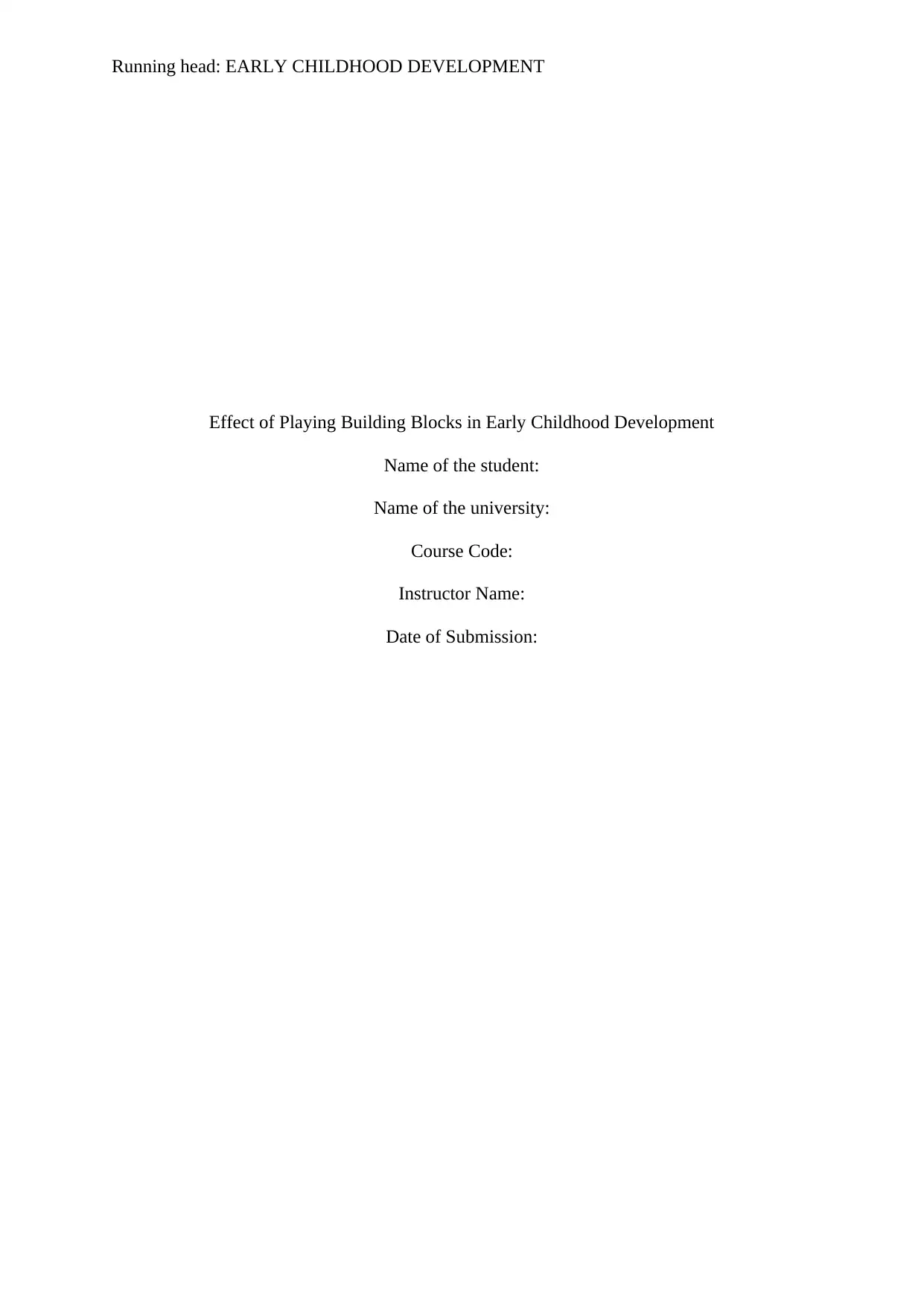
Running head: EARLY CHILDHOOD DEVELOPMENT
Effect of Playing Building Blocks in Early Childhood Development
Name of the student:
Name of the university:
Course Code:
Instructor Name:
Date of Submission:
Effect of Playing Building Blocks in Early Childhood Development
Name of the student:
Name of the university:
Course Code:
Instructor Name:
Date of Submission:
Paraphrase This Document
Need a fresh take? Get an instant paraphrase of this document with our AI Paraphraser

1EARLY CHILDHOOD DEVELOPMENT
Effect of Playing Building Blocks in Early Childhood Development
Introduction
Early childhood period falls in the age group of two to seven years. The learning of
children in this age group takes place in four primary areas of development namely the social,
emotional, physical and cognitive stages (Ahmad et.al., 2016, p. 1). At this stage, an
encouraging and nurturing environment is required to guide them in exploration. For
example, in cognitive area development at this age, they tend to frame and apply their own
decisions through creativity. In this pre-school stage, they tend to think in an ego-centric way
and start expressing their own needs. They develop a healthy sense of curiosity and eagerness
to join in groups and build connections (Slentz, 2017, pp.142-143). Thus, the paper aims in
discussing the activity of building blocks by children in early childhood and how does it
affect their development in the cognitive area. It also discusses the activity through
Erickson’s psychosocial stage and Piaget’s cognitive development stage. The paper also
focuses on the negative environmental factor and the preventive as well as the intervention
measure to mitigate the adverse effects.
Discussion
Building blocks in Early Childhood
Playing with building blocks help the children in early childhood to develop spatial
skills. They tend to build the ability to manipulate information about objects and find the
missing spaces. The child learns to measure the geometrical shapes of blocks (Verdine et al.,
2014, pp. 7-13). The mechanism of finding the symmetric pieces and measuring to match the
respective parts enhance their mathematics skills. The children get to explore new ideas and
improve eye with hand coordination. The logic, as well as creative stimulation, get built
through this activity. The children can learn problem-solving through communication with
Effect of Playing Building Blocks in Early Childhood Development
Introduction
Early childhood period falls in the age group of two to seven years. The learning of
children in this age group takes place in four primary areas of development namely the social,
emotional, physical and cognitive stages (Ahmad et.al., 2016, p. 1). At this stage, an
encouraging and nurturing environment is required to guide them in exploration. For
example, in cognitive area development at this age, they tend to frame and apply their own
decisions through creativity. In this pre-school stage, they tend to think in an ego-centric way
and start expressing their own needs. They develop a healthy sense of curiosity and eagerness
to join in groups and build connections (Slentz, 2017, pp.142-143). Thus, the paper aims in
discussing the activity of building blocks by children in early childhood and how does it
affect their development in the cognitive area. It also discusses the activity through
Erickson’s psychosocial stage and Piaget’s cognitive development stage. The paper also
focuses on the negative environmental factor and the preventive as well as the intervention
measure to mitigate the adverse effects.
Discussion
Building blocks in Early Childhood
Playing with building blocks help the children in early childhood to develop spatial
skills. They tend to build the ability to manipulate information about objects and find the
missing spaces. The child learns to measure the geometrical shapes of blocks (Verdine et al.,
2014, pp. 7-13). The mechanism of finding the symmetric pieces and measuring to match the
respective parts enhance their mathematics skills. The children get to explore new ideas and
improve eye with hand coordination. The logic, as well as creative stimulation, get built
through this activity. The children can learn problem-solving through communication with
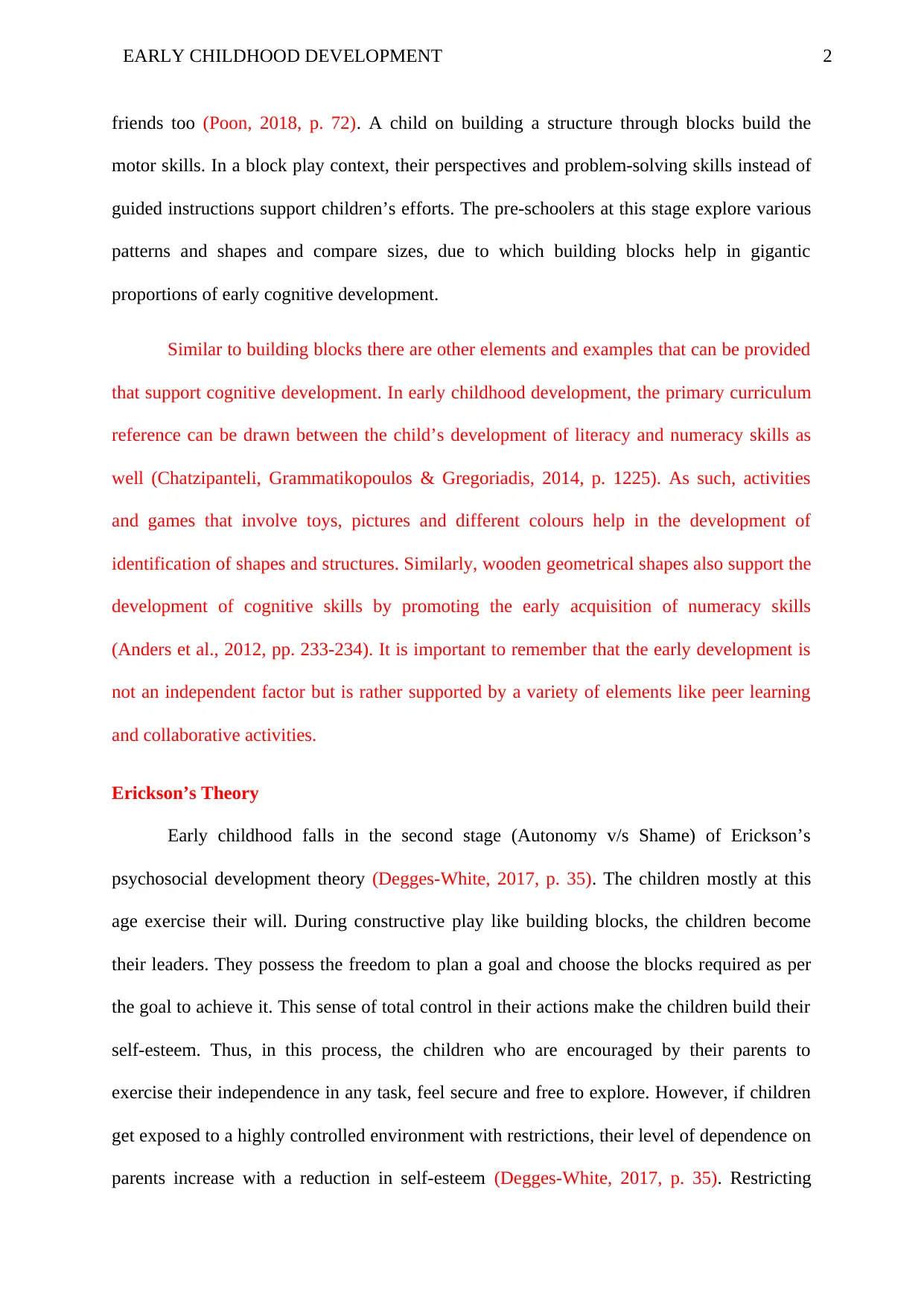
2EARLY CHILDHOOD DEVELOPMENT
friends too (Poon, 2018, p. 72). A child on building a structure through blocks build the
motor skills. In a block play context, their perspectives and problem-solving skills instead of
guided instructions support children’s efforts. The pre-schoolers at this stage explore various
patterns and shapes and compare sizes, due to which building blocks help in gigantic
proportions of early cognitive development.
Similar to building blocks there are other elements and examples that can be provided
that support cognitive development. In early childhood development, the primary curriculum
reference can be drawn between the child’s development of literacy and numeracy skills as
well (Chatzipanteli, Grammatikopoulos & Gregoriadis, 2014, p. 1225). As such, activities
and games that involve toys, pictures and different colours help in the development of
identification of shapes and structures. Similarly, wooden geometrical shapes also support the
development of cognitive skills by promoting the early acquisition of numeracy skills
(Anders et al., 2012, pp. 233-234). It is important to remember that the early development is
not an independent factor but is rather supported by a variety of elements like peer learning
and collaborative activities.
Erickson’s Theory
Early childhood falls in the second stage (Autonomy v/s Shame) of Erickson’s
psychosocial development theory (Degges-White, 2017, p. 35). The children mostly at this
age exercise their will. During constructive play like building blocks, the children become
their leaders. They possess the freedom to plan a goal and choose the blocks required as per
the goal to achieve it. This sense of total control in their actions make the children build their
self-esteem. Thus, in this process, the children who are encouraged by their parents to
exercise their independence in any task, feel secure and free to explore. However, if children
get exposed to a highly controlled environment with restrictions, their level of dependence on
parents increase with a reduction in self-esteem (Degges-White, 2017, p. 35). Restricting
friends too (Poon, 2018, p. 72). A child on building a structure through blocks build the
motor skills. In a block play context, their perspectives and problem-solving skills instead of
guided instructions support children’s efforts. The pre-schoolers at this stage explore various
patterns and shapes and compare sizes, due to which building blocks help in gigantic
proportions of early cognitive development.
Similar to building blocks there are other elements and examples that can be provided
that support cognitive development. In early childhood development, the primary curriculum
reference can be drawn between the child’s development of literacy and numeracy skills as
well (Chatzipanteli, Grammatikopoulos & Gregoriadis, 2014, p. 1225). As such, activities
and games that involve toys, pictures and different colours help in the development of
identification of shapes and structures. Similarly, wooden geometrical shapes also support the
development of cognitive skills by promoting the early acquisition of numeracy skills
(Anders et al., 2012, pp. 233-234). It is important to remember that the early development is
not an independent factor but is rather supported by a variety of elements like peer learning
and collaborative activities.
Erickson’s Theory
Early childhood falls in the second stage (Autonomy v/s Shame) of Erickson’s
psychosocial development theory (Degges-White, 2017, p. 35). The children mostly at this
age exercise their will. During constructive play like building blocks, the children become
their leaders. They possess the freedom to plan a goal and choose the blocks required as per
the goal to achieve it. This sense of total control in their actions make the children build their
self-esteem. Thus, in this process, the children who are encouraged by their parents to
exercise their independence in any task, feel secure and free to explore. However, if children
get exposed to a highly controlled environment with restrictions, their level of dependence on
parents increase with a reduction in self-esteem (Degges-White, 2017, p. 35). Restricting
⊘ This is a preview!⊘
Do you want full access?
Subscribe today to unlock all pages.

Trusted by 1+ million students worldwide
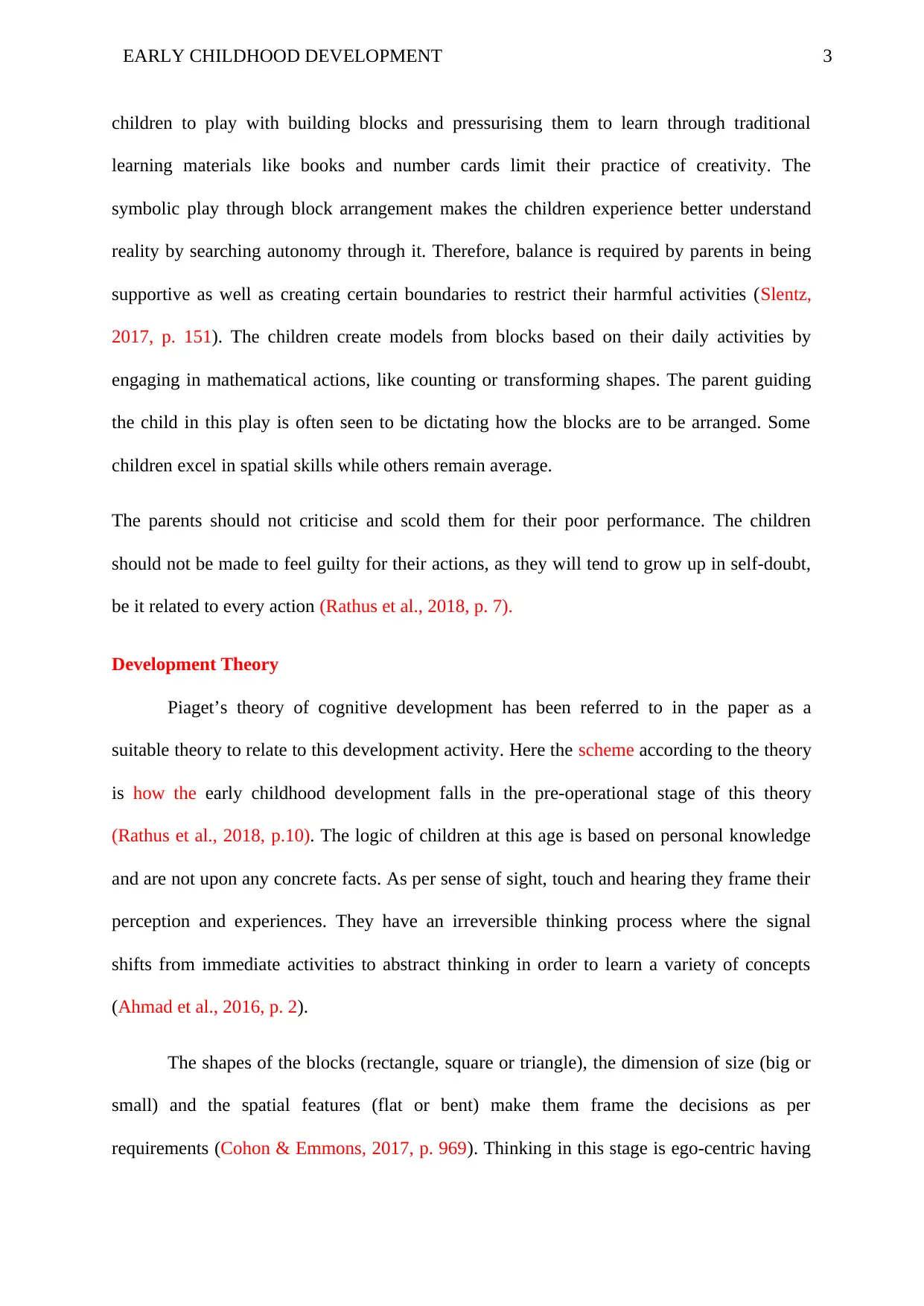
3EARLY CHILDHOOD DEVELOPMENT
children to play with building blocks and pressurising them to learn through traditional
learning materials like books and number cards limit their practice of creativity. The
symbolic play through block arrangement makes the children experience better understand
reality by searching autonomy through it. Therefore, balance is required by parents in being
supportive as well as creating certain boundaries to restrict their harmful activities (Slentz,
2017, p. 151). The children create models from blocks based on their daily activities by
engaging in mathematical actions, like counting or transforming shapes. The parent guiding
the child in this play is often seen to be dictating how the blocks are to be arranged. Some
children excel in spatial skills while others remain average.
The parents should not criticise and scold them for their poor performance. The children
should not be made to feel guilty for their actions, as they will tend to grow up in self-doubt,
be it related to every action (Rathus et al., 2018, p. 7).
Development Theory
Piaget’s theory of cognitive development has been referred to in the paper as a
suitable theory to relate to this development activity. Here the scheme according to the theory
is how the early childhood development falls in the pre-operational stage of this theory
(Rathus et al., 2018, p.10). The logic of children at this age is based on personal knowledge
and are not upon any concrete facts. As per sense of sight, touch and hearing they frame their
perception and experiences. They have an irreversible thinking process where the signal
shifts from immediate activities to abstract thinking in order to learn a variety of concepts
(Ahmad et al., 2016, p. 2).
The shapes of the blocks (rectangle, square or triangle), the dimension of size (big or
small) and the spatial features (flat or bent) make them frame the decisions as per
requirements (Cohon & Emmons, 2017, p. 969). Thinking in this stage is ego-centric having
children to play with building blocks and pressurising them to learn through traditional
learning materials like books and number cards limit their practice of creativity. The
symbolic play through block arrangement makes the children experience better understand
reality by searching autonomy through it. Therefore, balance is required by parents in being
supportive as well as creating certain boundaries to restrict their harmful activities (Slentz,
2017, p. 151). The children create models from blocks based on their daily activities by
engaging in mathematical actions, like counting or transforming shapes. The parent guiding
the child in this play is often seen to be dictating how the blocks are to be arranged. Some
children excel in spatial skills while others remain average.
The parents should not criticise and scold them for their poor performance. The children
should not be made to feel guilty for their actions, as they will tend to grow up in self-doubt,
be it related to every action (Rathus et al., 2018, p. 7).
Development Theory
Piaget’s theory of cognitive development has been referred to in the paper as a
suitable theory to relate to this development activity. Here the scheme according to the theory
is how the early childhood development falls in the pre-operational stage of this theory
(Rathus et al., 2018, p.10). The logic of children at this age is based on personal knowledge
and are not upon any concrete facts. As per sense of sight, touch and hearing they frame their
perception and experiences. They have an irreversible thinking process where the signal
shifts from immediate activities to abstract thinking in order to learn a variety of concepts
(Ahmad et al., 2016, p. 2).
The shapes of the blocks (rectangle, square or triangle), the dimension of size (big or
small) and the spatial features (flat or bent) make them frame the decisions as per
requirements (Cohon & Emmons, 2017, p. 969). Thinking in this stage is ego-centric having
Paraphrase This Document
Need a fresh take? Get an instant paraphrase of this document with our AI Paraphraser

4EARLY CHILDHOOD DEVELOPMENT
difficulty to feel the opinions of others. The children on placing each successive block next to
the previous block realise that blocks do not fall when so positioned. On building large
towers of building, they learn to make it stable in its structure knowing gravity and balance in
real life. Their creativity gets framed as per the structure in their mind. In this stage, they like
to exercise the thought through mathematical operations, estimating negative space,
arrangement as per space, size and structure. In this stage, the children learn to view the cause
and effect relationships on each aspect. They build buildings in multiple directions showing
flexibility in problem solving and adjustments.
Interfering Environmental Factor
The negative environmental factor here is inadequacy and biases in the learning
environment at home. The inadequacy arises most due to the differences in income level and
education of parents in the family environment of children. Children from low-income
families often do not have the opportunities to engage in spatial learning through building
blocks in their play. In many families, the girl child often gets less exposure to build their
spatial and motor skills through building blocks games (Jirout & Newcombe, 2015, pp. 302-
310). Their play is restricted to the cooking and dolls thereby, increasing the chances of
spatial advantages to boys. This type of gender biases in learning environment makes the girl
children go through emotional trauma and questioning their identity. They undergo shame
and guilt as per Erickson’s psychosocial theory for being born as girls. These children thus
develop negative emotions like jealousy, anger, guilt and limit their knowledge capacity. The
children at this age of development want a supportive environment, but the restrictive
parenting style creates barriers in their exploration. The families with low income make their
children resort to traditional learning practices which degrade their cognitive development.
The children get more dependent on their parents to base their decisions in future with no
freedom of their own opinions.
difficulty to feel the opinions of others. The children on placing each successive block next to
the previous block realise that blocks do not fall when so positioned. On building large
towers of building, they learn to make it stable in its structure knowing gravity and balance in
real life. Their creativity gets framed as per the structure in their mind. In this stage, they like
to exercise the thought through mathematical operations, estimating negative space,
arrangement as per space, size and structure. In this stage, the children learn to view the cause
and effect relationships on each aspect. They build buildings in multiple directions showing
flexibility in problem solving and adjustments.
Interfering Environmental Factor
The negative environmental factor here is inadequacy and biases in the learning
environment at home. The inadequacy arises most due to the differences in income level and
education of parents in the family environment of children. Children from low-income
families often do not have the opportunities to engage in spatial learning through building
blocks in their play. In many families, the girl child often gets less exposure to build their
spatial and motor skills through building blocks games (Jirout & Newcombe, 2015, pp. 302-
310). Their play is restricted to the cooking and dolls thereby, increasing the chances of
spatial advantages to boys. This type of gender biases in learning environment makes the girl
children go through emotional trauma and questioning their identity. They undergo shame
and guilt as per Erickson’s psychosocial theory for being born as girls. These children thus
develop negative emotions like jealousy, anger, guilt and limit their knowledge capacity. The
children at this age of development want a supportive environment, but the restrictive
parenting style creates barriers in their exploration. The families with low income make their
children resort to traditional learning practices which degrade their cognitive development.
The children get more dependent on their parents to base their decisions in future with no
freedom of their own opinions.

5EARLY CHILDHOOD DEVELOPMENT
Preventive Measures
The two preventive measures to protect the children from this negative environmental
factor before occurring are:
A non-biased learning culture in the family- The family should embrace a non-biased
learning culture in the home where both the girl and the boy children can collaborate and play
with the building blocks. It will not only help in building cognitive skills but also grow the
bond and social skills through communication and positive behaviours like teamwork. The
encouragement of children in exploring their interests and opinions should not be limited to
their genders. They should learn to apply cognitive skills efficiently through spatial training
from both parents. It is also to be noted that the children in front of siblings, as well as peers,
should not be criticised for the average performance. The parents should appreciate their little
efforts and not judge them based on their intelligence scale.
Supporting children in development- The financial structure of a family should also not
restrict the growth of children’s cognitive development as it will affect their future. The
children should be supported to upgrade their learning skills rather than restricting them to
traditional methods through books only. Their intelligence should not be enclosed in a box. It
is the responsibility of the parents to care for the development of their children in this
cognitive area which is often neglected due to their busy lives. The decisions of their children
should be allowed by parents in making them exercising their own will rather than forcing
them to resort to ways they feel is against their will. It will build positive behaviours in them
like honesty, autonomy and independence with pride in their actions.
Intervention Measures
The two intervention measures to minimise the negative impacts of an environmental
factor after occurring are:
Preventive Measures
The two preventive measures to protect the children from this negative environmental
factor before occurring are:
A non-biased learning culture in the family- The family should embrace a non-biased
learning culture in the home where both the girl and the boy children can collaborate and play
with the building blocks. It will not only help in building cognitive skills but also grow the
bond and social skills through communication and positive behaviours like teamwork. The
encouragement of children in exploring their interests and opinions should not be limited to
their genders. They should learn to apply cognitive skills efficiently through spatial training
from both parents. It is also to be noted that the children in front of siblings, as well as peers,
should not be criticised for the average performance. The parents should appreciate their little
efforts and not judge them based on their intelligence scale.
Supporting children in development- The financial structure of a family should also not
restrict the growth of children’s cognitive development as it will affect their future. The
children should be supported to upgrade their learning skills rather than restricting them to
traditional methods through books only. Their intelligence should not be enclosed in a box. It
is the responsibility of the parents to care for the development of their children in this
cognitive area which is often neglected due to their busy lives. The decisions of their children
should be allowed by parents in making them exercising their own will rather than forcing
them to resort to ways they feel is against their will. It will build positive behaviours in them
like honesty, autonomy and independence with pride in their actions.
Intervention Measures
The two intervention measures to minimise the negative impacts of an environmental
factor after occurring are:
⊘ This is a preview!⊘
Do you want full access?
Subscribe today to unlock all pages.

Trusted by 1+ million students worldwide
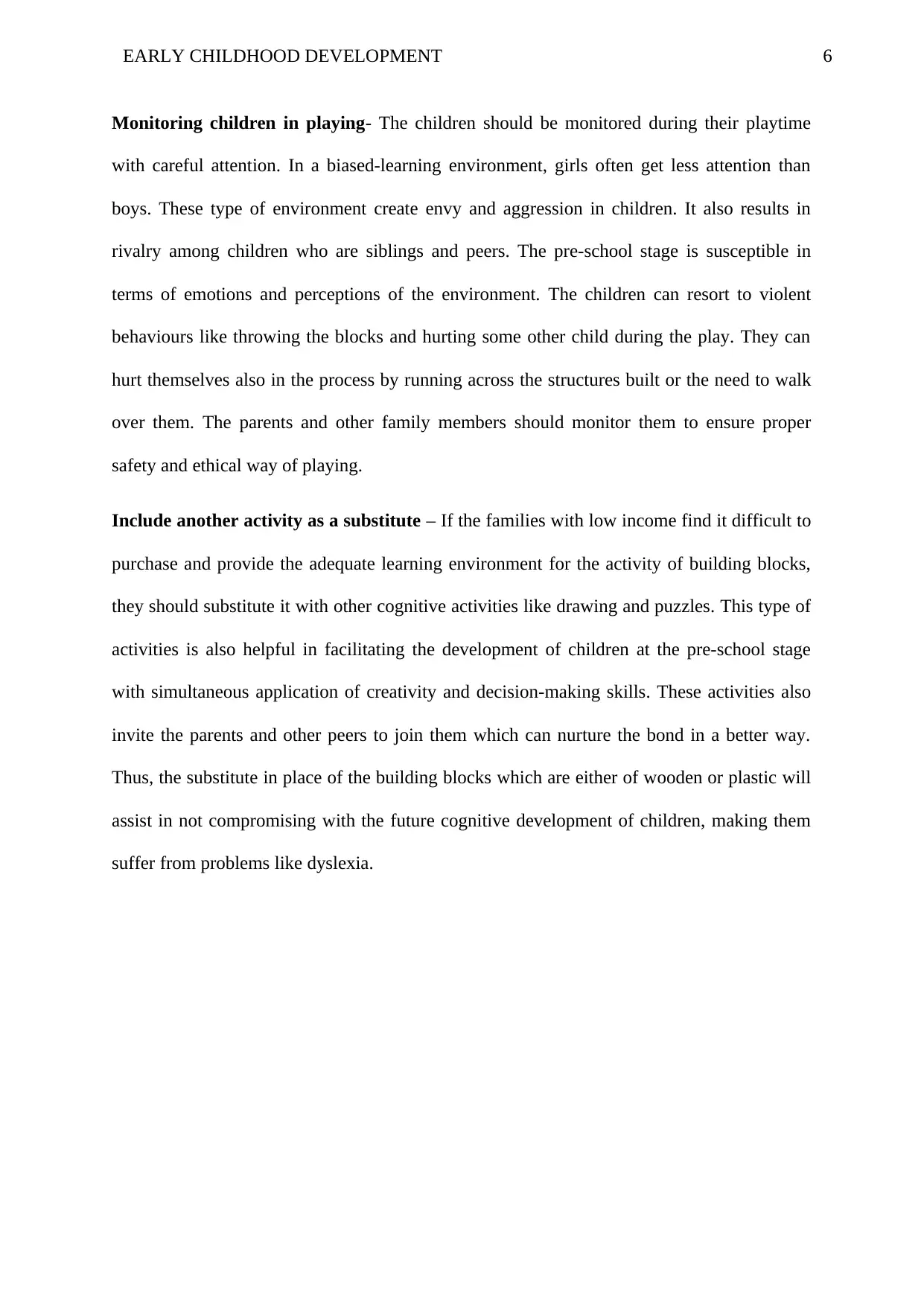
6EARLY CHILDHOOD DEVELOPMENT
Monitoring children in playing- The children should be monitored during their playtime
with careful attention. In a biased-learning environment, girls often get less attention than
boys. These type of environment create envy and aggression in children. It also results in
rivalry among children who are siblings and peers. The pre-school stage is susceptible in
terms of emotions and perceptions of the environment. The children can resort to violent
behaviours like throwing the blocks and hurting some other child during the play. They can
hurt themselves also in the process by running across the structures built or the need to walk
over them. The parents and other family members should monitor them to ensure proper
safety and ethical way of playing.
Include another activity as a substitute – If the families with low income find it difficult to
purchase and provide the adequate learning environment for the activity of building blocks,
they should substitute it with other cognitive activities like drawing and puzzles. This type of
activities is also helpful in facilitating the development of children at the pre-school stage
with simultaneous application of creativity and decision-making skills. These activities also
invite the parents and other peers to join them which can nurture the bond in a better way.
Thus, the substitute in place of the building blocks which are either of wooden or plastic will
assist in not compromising with the future cognitive development of children, making them
suffer from problems like dyslexia.
Monitoring children in playing- The children should be monitored during their playtime
with careful attention. In a biased-learning environment, girls often get less attention than
boys. These type of environment create envy and aggression in children. It also results in
rivalry among children who are siblings and peers. The pre-school stage is susceptible in
terms of emotions and perceptions of the environment. The children can resort to violent
behaviours like throwing the blocks and hurting some other child during the play. They can
hurt themselves also in the process by running across the structures built or the need to walk
over them. The parents and other family members should monitor them to ensure proper
safety and ethical way of playing.
Include another activity as a substitute – If the families with low income find it difficult to
purchase and provide the adequate learning environment for the activity of building blocks,
they should substitute it with other cognitive activities like drawing and puzzles. This type of
activities is also helpful in facilitating the development of children at the pre-school stage
with simultaneous application of creativity and decision-making skills. These activities also
invite the parents and other peers to join them which can nurture the bond in a better way.
Thus, the substitute in place of the building blocks which are either of wooden or plastic will
assist in not compromising with the future cognitive development of children, making them
suffer from problems like dyslexia.
Paraphrase This Document
Need a fresh take? Get an instant paraphrase of this document with our AI Paraphraser
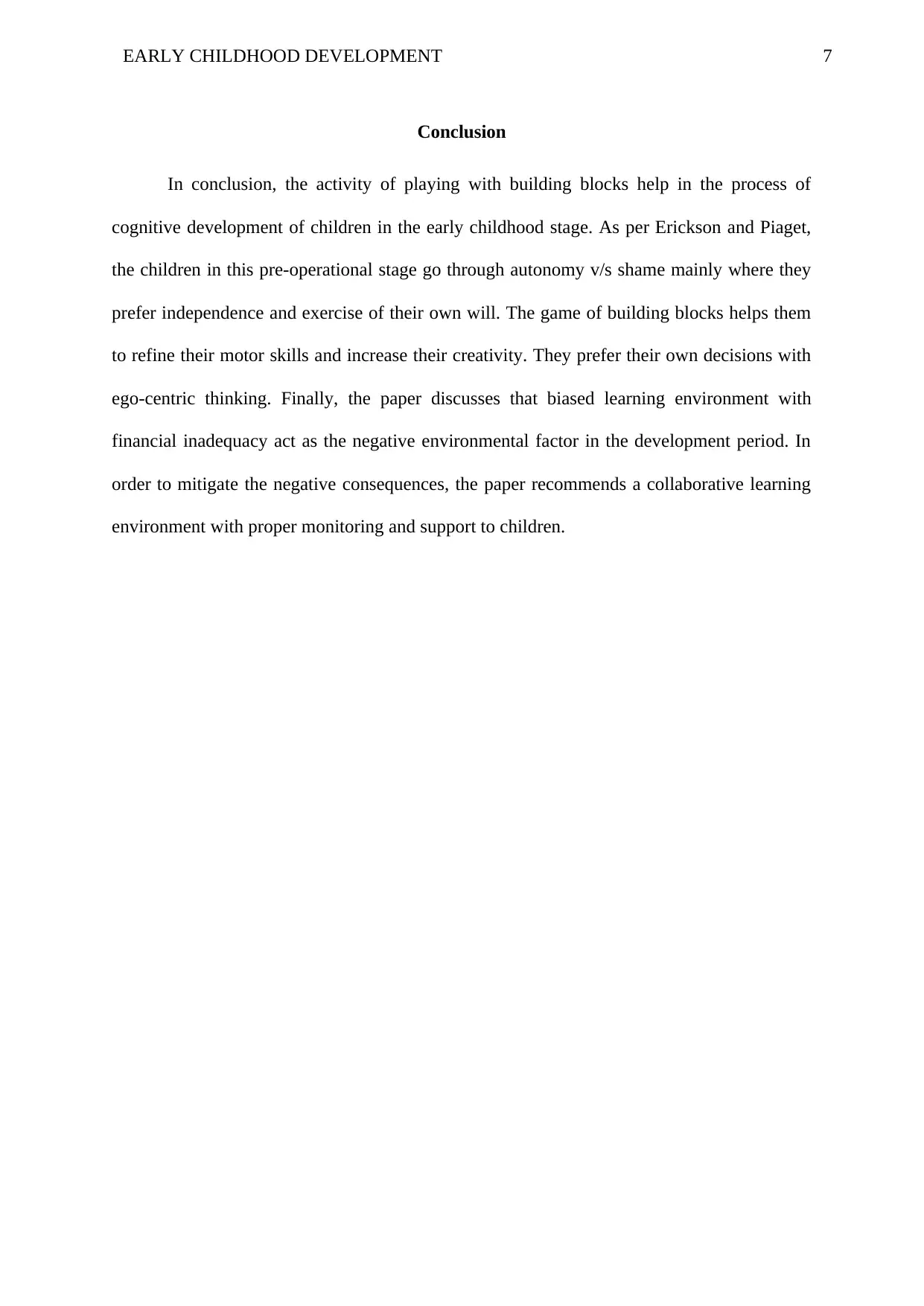
7EARLY CHILDHOOD DEVELOPMENT
Conclusion
In conclusion, the activity of playing with building blocks help in the process of
cognitive development of children in the early childhood stage. As per Erickson and Piaget,
the children in this pre-operational stage go through autonomy v/s shame mainly where they
prefer independence and exercise of their own will. The game of building blocks helps them
to refine their motor skills and increase their creativity. They prefer their own decisions with
ego-centric thinking. Finally, the paper discusses that biased learning environment with
financial inadequacy act as the negative environmental factor in the development period. In
order to mitigate the negative consequences, the paper recommends a collaborative learning
environment with proper monitoring and support to children.
Conclusion
In conclusion, the activity of playing with building blocks help in the process of
cognitive development of children in the early childhood stage. As per Erickson and Piaget,
the children in this pre-operational stage go through autonomy v/s shame mainly where they
prefer independence and exercise of their own will. The game of building blocks helps them
to refine their motor skills and increase their creativity. They prefer their own decisions with
ego-centric thinking. Finally, the paper discusses that biased learning environment with
financial inadequacy act as the negative environmental factor in the development period. In
order to mitigate the negative consequences, the paper recommends a collaborative learning
environment with proper monitoring and support to children.

8EARLY CHILDHOOD DEVELOPMENT
References
Ahmad, S., Batool, A., Sittar, K., & Malik, D. M. (2016). Play and Cognitive Development:
Formal Operational Perspective of Piaget’s Theory. Journal of Education and
Practice, (pp. 1–3).
Anders, Y., Rossbach, H. G., Weinert, S., Ebert, S., Kuger, S., Lehrl, S., & von Maurice, J.
(2012). Home and preschool learning environments and their relations to the
development of early numeracy skills. Early Childhood Research Quarterly, 27(2),
231-244.
Chatzipanteli, A., Grammatikopoulos, V., & Gregoriadis, A. (2014). Development and
evaluation of metacognition in early childhood education. Early child development
and care, 184(8), 1223-1232.
Cohen, L. E., & Emmons, J. (2017). Block play: spatial language with preschool and school-
aged children. Early Child Development and Care, 187(5-6), 967-977.
Degges-White, S. (2017). Erikson’s Theory of Psychosocial Development. College Student
Development: Applying Theory to Practice on the Diverse Campus, 35.
Jirout, J. J., & Newcombe, N. S. (2015). Building blocks for developing spatial skills.
Psychological science, 26(3), 302-310.
Poon, S. T. (2018). LEGO as a Learning Enabler. Journal of Urban Culture Research, 72.
Rathus, S., Longmuir, S., Berk, L. E., & Rogerson, R. (2018). Retrieved from HDEV (3rd
ed.).
Slentz, K. (2017). Early childhood development and its variations. Routledge, (pp.140-157)
References
Ahmad, S., Batool, A., Sittar, K., & Malik, D. M. (2016). Play and Cognitive Development:
Formal Operational Perspective of Piaget’s Theory. Journal of Education and
Practice, (pp. 1–3).
Anders, Y., Rossbach, H. G., Weinert, S., Ebert, S., Kuger, S., Lehrl, S., & von Maurice, J.
(2012). Home and preschool learning environments and their relations to the
development of early numeracy skills. Early Childhood Research Quarterly, 27(2),
231-244.
Chatzipanteli, A., Grammatikopoulos, V., & Gregoriadis, A. (2014). Development and
evaluation of metacognition in early childhood education. Early child development
and care, 184(8), 1223-1232.
Cohen, L. E., & Emmons, J. (2017). Block play: spatial language with preschool and school-
aged children. Early Child Development and Care, 187(5-6), 967-977.
Degges-White, S. (2017). Erikson’s Theory of Psychosocial Development. College Student
Development: Applying Theory to Practice on the Diverse Campus, 35.
Jirout, J. J., & Newcombe, N. S. (2015). Building blocks for developing spatial skills.
Psychological science, 26(3), 302-310.
Poon, S. T. (2018). LEGO as a Learning Enabler. Journal of Urban Culture Research, 72.
Rathus, S., Longmuir, S., Berk, L. E., & Rogerson, R. (2018). Retrieved from HDEV (3rd
ed.).
Slentz, K. (2017). Early childhood development and its variations. Routledge, (pp.140-157)
⊘ This is a preview!⊘
Do you want full access?
Subscribe today to unlock all pages.

Trusted by 1+ million students worldwide
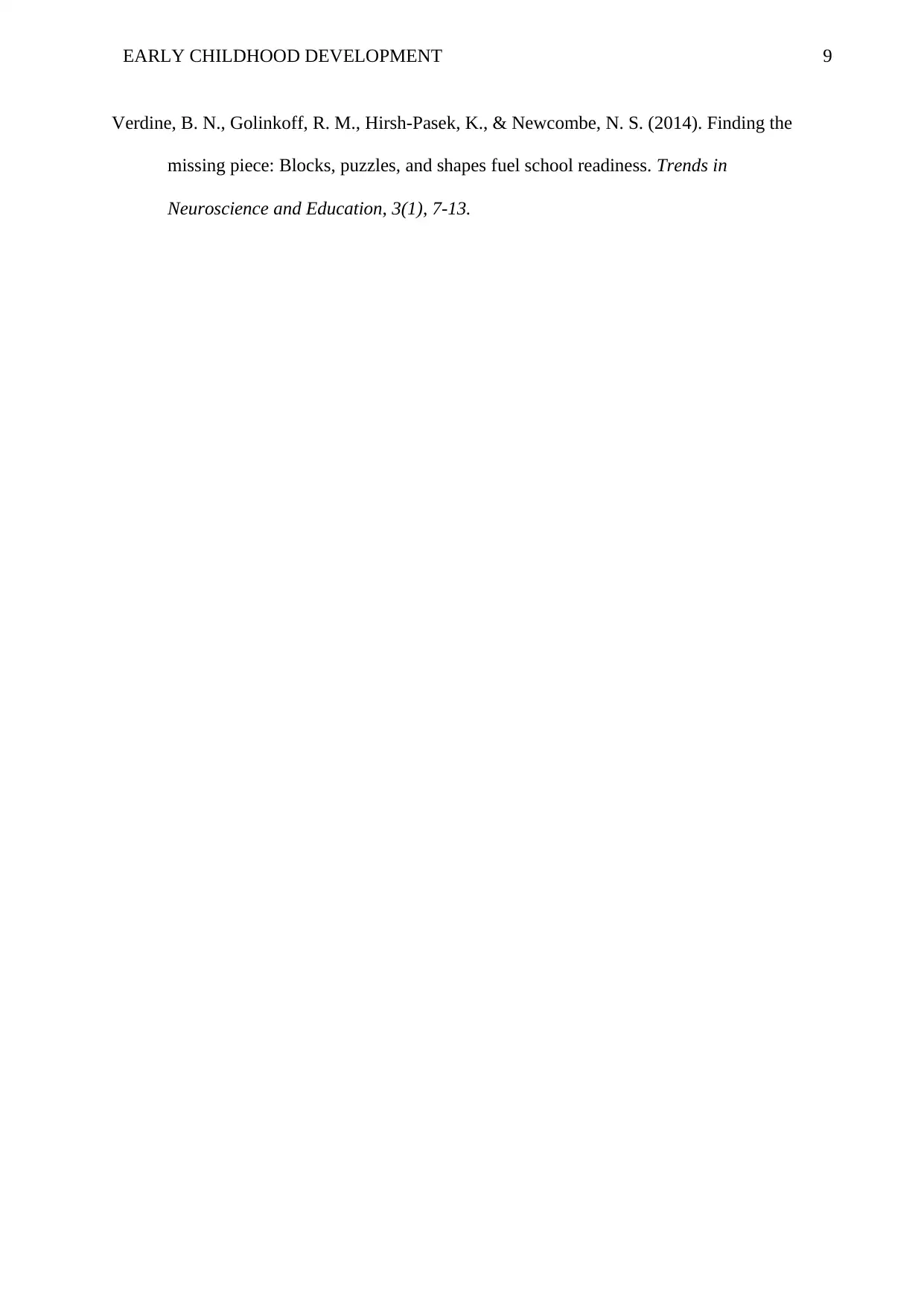
9EARLY CHILDHOOD DEVELOPMENT
Verdine, B. N., Golinkoff, R. M., Hirsh-Pasek, K., & Newcombe, N. S. (2014). Finding the
missing piece: Blocks, puzzles, and shapes fuel school readiness. Trends in
Neuroscience and Education, 3(1), 7-13.
Verdine, B. N., Golinkoff, R. M., Hirsh-Pasek, K., & Newcombe, N. S. (2014). Finding the
missing piece: Blocks, puzzles, and shapes fuel school readiness. Trends in
Neuroscience and Education, 3(1), 7-13.
1 out of 10
Related Documents
Your All-in-One AI-Powered Toolkit for Academic Success.
+13062052269
info@desklib.com
Available 24*7 on WhatsApp / Email
![[object Object]](/_next/static/media/star-bottom.7253800d.svg)
Unlock your academic potential
Copyright © 2020–2025 A2Z Services. All Rights Reserved. Developed and managed by ZUCOL.





